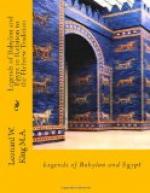(1) See Cook, The Laws of Moses and the Code of Hammurabi, p. 281 f.; Driver, Genesis, p. xxxvi f.; and cf. Johns, The Laws of Babylonia and the Laws of the Hebrew Peoples (Schweich Lectures, 1912), pp. 50 ff.
During the second period, that of the settlement in Canaan, the Hebrews came into contact with a people who had used the Babylonian language as the common medium of communication throughout the Near East. It is an interesting fact that among the numerous letters found at Tell el-Amarna were two texts of quite a different character. These were legends, both in the form of school exercises, which had been written out for practice in the Babylonian tongue. One of them was the legend of Adapa, in which we noted just now a distant resemblance to the Hebrew story of Paradise. It seems to me we are here standing on rather firmer ground; and provisionally we might place the beginning of our process after the time of Hebrew contact with the Canaanites.
Under the earlier Hebrew monarchy there was no fresh influx of Babylonian culture into Palestine. That does not occur till our last main period, the later Judaean monarchy, when, in consequence of the westward advance of Assyria, the civilization of Babylon was once more carried among the petty Syrian states. Israel was first drawn into the circle of Assyrian influence, when Arab fought as the ally of Benhadad of Damascus at the battle of Karkar in 854 B.C.; and from that date onward the nation was menaced by the invading power. In 734 B.C., at the invitation of Ahaz of Judah, Tiglath-Pileser IV definitely intervened in the affairs of Israel. For Ahaz purchased his help against the allied armies of Israel and Syria in the Syro-Ephraimitish war. Tiglath-pileser threw his forces against Damascus and Israel, and Ahaz became his vassal.(1) To this period, when Ahaz, like Panammu II, “ran at the wheel of his lord, the king of Assyria”, we may ascribe the first marked invasion of Assyrian influence over Judah. Traces of it may be seen in the altar which Ahaz caused to be erected in Jerusalem after the pattern of the Assyrian altar at Damascus.(2) We saw in the first lecture, in the monuments we have recovered of Panammu I and of Bar-rekub, how the life of another small Syrian state was inevitably changed and thrown into new channels by the presence of Tiglath-pileser and his armies in the West.
(1) 2 Kings xvi. 7 ff.
(2) 2 Kings xvi. 10 ff.




